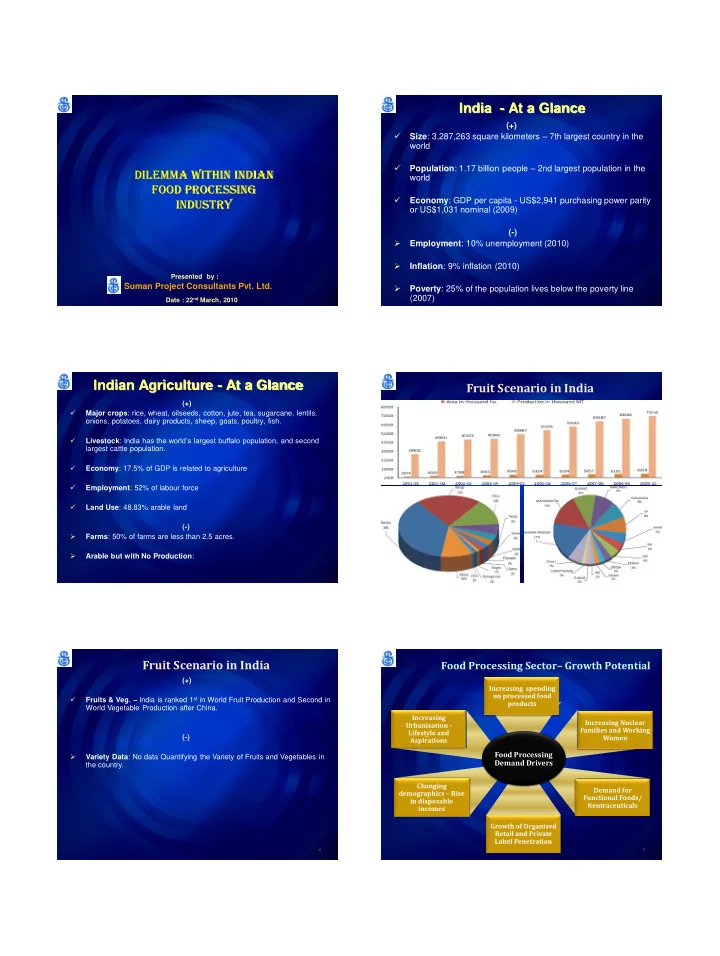

India - At a Glance (+) Size : 3,287,263 square kilometers – 7th largest country in the world Population : 1.17 billion people – 2nd largest population in the Dilemma WITHIN INDIAN world FOOD PROCESSING Economy : GDP per capita - US$2,941 purchasing power parity INDUSTRY or US$1,031 nominal (2009) (-) Employment : 10% unemployment (2010) Inflation : 9% inflation (2010) Presented by : Suman Project Consultants Pvt. Ltd. Poverty : 25% of the population lives below the poverty line (2007) Date : 22 nd March, 2010 Indian Agriculture - At a Glance Fruit Scenario in India (+) Major crops : rice, wheat, oilseeds, cotton, jute, tea, sugarcane, lentils, onions, potatoes, dairy products, sheep, goats, poultry, fish. Livestock : India has the world’s largest buffalo population, and second largest cattle population. Economy : 17.5% of GDP is related to agriculture Employment : 52% of labour force Land Use : 48.83% arable land (-) Farms : 50% of farms are less than 2.5 acres. Arable but with No Production : 6 Fruit Scenario in India Food Processing Sector – Growth Potential (+) Increasing spending on processed food Fruits & Veg. – India is ranked 1 st in World Fruit Production and Second in products World Vegetable Production after China. Increasing Increasing Nuclear Urbanisation - Families and Working Lifestyle and (-) Women Aspirations Food Processing Variety Data : No data Quantifying the Variety of Fruits and Vegetables in Demand Drivers the country. Changing Demand for demographics – Rise Functional Foods/ in disposable Neutraceuticals incomes Growth of Organised Retail and Private Label Penetration 6 5
Food Processing Sector – Impediments Wastage of Agriculture Produce Supply Chain Infra Gaps A nation wide study on quantitative assessment of harvest and post (Lack of primary processing, storage and harvest losses for 46 agricultural produces in 106 randomly selected distribution facilities) districts was carried out by CIPHET. Supply Chain Institutional Gaps Inadequate link Percentage of losses estimated for major produces. (Middlemen / between production and commission agents ) processing (lack of processable varieties) Crop Cumulative Wastage (%) Challenges for Cereals 3.9-6.0 Food Processing Sector Pulses 4.3-6.1 Oil Seeds 6.0 Fruits & Vegetables 5.8-18.0 Seasonality of Lack of product Milk 0.8 operations and low development and capacity utilization Fisheries 2.9 Innovation Meat 2.3 Poultry 3.7 Enforcement of quality and safety standards Source: A study by CIPHET, 2010 6 4 Supply chain – a comparison with Developed countries Growth of Food Processing Sector India Capital Investment in Registered Units in Food Processing Sector (Rs. in Crore) Retailer Consumer Trader Wholesaler Commission Consolidator Farmer Invested Capital Working Capital Fixed Capital agent 2007-2008 High wastage and 2006-2007 low margins 2005-2006 2004-2005 2003-2004 Developed countries Consumer 2002-2003 Retailer 2001-2002 Wholesaler 2000-2001 Farmer High investments – Low wastage - 1999-2000 better margins 1998-1999 0 20000 40000 60000 80000 100000 120000 140000 Source: Annual Survey of Industries 3 Govt. of India Policy Govt. of India Policy (+) (-) Dedicated Ministry : We have a dedicated ministry which has contributed. Import Duty : The import duty for imported plant & machinery is approx 30%. China, on the other hand, gives incentive / subsidy of 30% for importing plant & machinery. Import duty needs to be reduced to enhance Subsidy : Subsidy is available from MoFPI for setting up of Food the competetive edge of Indian Food Processing Industry. Processing Plants / Infrastructure projects. Plant & Machinery suppliers : No incentives to the backbone of the (-) Industry. Approvals : The gestation period for approval of subsidy application is significant. Should be Maximum of 3 months from date of application and within 2 months of receipt of request Subsidy : Subsidy cap for last decade has remained the same while the cost of establishing Food processing plants has significantly increased. Prioritizing Priorities : Govt. priority has narrowed down to Infrastructure. Need to rejuvenate Small and Medium enterprises / entrepreneurship within Food Processing sector.
Suggestions Farm Size : Increase farm size by involving private sector. Put reasonable production & productivity goals. Variety Data : Appoint Multi agency Multi Sate agencies to track and collect variety data of Fruits and Vegetables. Encourage Small & Medium Enterprises : Subsidy should be 25% of How do we conclude this Dilemma ? Technical Infrastructure. Cap on subsidy should be increased to at least Rs. 1 Cr, if not more. Plant & Machinery suppliers : Incentives to enterprenuer in case he sources Indian manufactured goods. “Buy Indian” policy will lead to number of Foreign companies set up their “Fabrication Units” in India. No incentives to the backbone of the Industry. Encourage R & D. Import Duty : Import duty of Food Processing machinery needs to be reduced to a minimum of 5%. APMC Act : Amend APMC act to enable direct procurement from Farmers. Should encourage private sector participation. Thank You Contact : Suman Project Consultants Pvt. Ltd. B-168 East of Kailash New Delhi – 110065 Tel #: 011-26848961 / 26313391
Recommend
More recommend